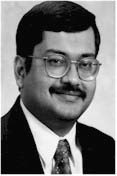Washington, March 8, 2004
By A. Singh
SMART CATALYSTS, a new device for trapping
and deactivating microbial particles has recently been patented.
It has the potential to benefit the war on terrorism by
deactivating airborne bioagents and bioweapons such as the
smallpox virus, anthrax, and ricin, as well as routine indoor
air ventilation applications, such as in buildings and aircraft
cabins. Biswas and his collaborators have tested the device
using non-potent polio virus and have achieved 99.9999 percent
efficiency
The device combines an electrical field
with soft rays and smart catalysts to capture and destroy
bioagents. "When the aerosol particles come into the
device they are charged and trapped in an electrical field,"
explained Pratim Biswas, Ph.D., Stifel & Quinette Jens
Professor of Environmental Engineering Sciences and director
of Environmental Engineering Sciences at Washington University.
"Any organic material is oxidized, so it completely
deactivates the organism."
Biswas noted that conventional corona systems
do not charge and effectively trap nanometer-sized particles,
such as viruses. But his invention combines soft x-rays
with a conventional corona that has been proven to be very
effective at charging and trapping particles in a range
of sizes.
The walls of the device have coated nanoparticles
that catalyze the oxidation. These nanoparticles are "smart"
objects that are turned "on" and "off"
by irradiation.
Washington University in St. Louis has a
core group of six faculty who are mainstream aerosol researchers,
and work on different aspects related to Aerosol Science
and Engineering. This nationally and internationally recognized
group of scientists, one of the largest groups in U. S.
universities, studies the synthesis and environmental impact
of nanoparticles, atmospheric pollution at the regional
and global scales, and develops the next generation of instrumentation
for detection of these particles, as well as several environmental
nanotechnology applications.
Biswas was part of a special colloquium,
"Research in Aerosols and Air Quality," held March
2, 2004, at Washington University. The event was organized
under the university's Sesquicentennial Environmental Initiative
wherein world-renowned researchers reported the latest findings
in the aerosol engineering field. The colloquium, was part
of a series of environmental dialogues held in honor of
Washington University's 150th anniversary.
PRATIM BISWAS
Stifel and Quinette Jens Professor
Director, Environmental Engineering Science
Washington University in St. Louis
Coordinates
Departments of Chemical and Civil Engineering
Environmental Engineering Science Program
Washington University in St. Louis
One Brookings Drive, Campus Box 1180
St. Louis, MO 63130-4899
The Aerosol and Air Quality Research Laboratory
(AAQRL) Educational and Research Interests Teaching and
research interests include aerosol science and engineering;
nanoparticle technology; air quality engineering;combustion;
materials processing for environmental technologies, environmentally
benign processing, environmental nanotechnology, and the
thermal sciences.
Education
1985 Ph.D. California Institute of Technology
1981 M.S. University of California, Los Angeles
1980 B.Tech. Indian Institute of Technology, Bombay
Professional Experience
2000 - current Jens Professor and Director, Environmental
Engr.
Washington University in St. Louis
1993 - 2000 Professor, University of Cincinnati
1998 - 2002 Associate Editor, Aerosol Science and Technology
1998 - 2000 Chair, Critical Review Committee, AWMA
1998- current Member, Critical Review Committee, AWMA
1998 - 2000 Board of Directors, AAAR, Executive Committee
1995 - 1998 Director, Environmental Engineering and Science
Div.
University of Cincinnati
1994 Visiting Scientist, Natl. Inst. of Stds. & Tech.
1989 - 1993 Associate Professor, University of Cincinnati
1985 - 1989 Assistant Professor, University of Cincinnati
1981 - 1985 Graduate Asst., California Institute of Technology
1980 - 1981 Graduate Asst., University of California, Los
Angeles
1979 Trainee Engineer, Voltas India Inc.
Classes That I Teach
1) Aerosol Science and Technology, Env/ChE 518
2) Advanced Topics in Aerosol Science, Env/ChE 592 (alternate
(even) years)
3) Topics in Nanotechnology, Env/ChE/ME 564 (alternate (odd)
years)
4) Environmental Engineering Science Seminar, Env 5908
5) Transport Phenomena, ChE 368
